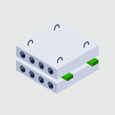
Ordinary Portland Cement, as the name suggests, is the most common form of cement, manufactured by heating limestone mineral with a mixture of clay or other materials of similar bulk composition and sufficient reactivity. Clinker nodules are formed as an intermediate product due to partial fusion of material at high temperature. This clinker is mixed with a controlled percentage of gypsum and finely grounded to make the final product cement.
It is mainly composed of (i) Argillaceous or silicates of alumina (clay and shale) and (ii) Calcareous or calcium carbonate (limestone, chalk, and marl) components.

Portland Pozzolana Cement (PPC) is produced by grinding ordinary clinker with pozzolanic materials, such as fly ash, alongside of addition of gypsum. It can also be prepared by uniformly blending OPC and fine pozzolana. A pozzolan is a siliceous or aluminosiliceous material that, in finely divided form and in presence of moisture, chemically reacts with the calcium hydroxide released by the hydration of Portland cement to form calcium silicate hydrate and other compounds possessing cementitious properties. Volcanic ashes and pumices are naturally occurring pozollanic materials. Fly ash, silica fume, rice husk ash, etc. are some of the most commonly used man made pozzolanic materials. These are also termed as supplementary cementitious materials.
PPC provides improved workability; less segregation and bleeding; increased water tightness; and reduced tendency of lime to separate. Furthermore, it prevents damage due to alkali reaction in concrete and enhances durability of marine structures in sulphate environment. It has a very low heat of hydration.

This type of cement is prepared by suitably replacing a portion of OPC with finely ground granulated blast furnace slag (GGBFS) along with addition of calcium sulphate activator. It is also popularly known as Portland Blast Furnace Slag Cement (PBFS). It has an ability to prevent leaching of lime as efflorescence in water seepage affected areas by way of formation of stable compounds. It is resistant to acidic as well as alkaline environment. PSC or PBFS is created with a blend of 45% to 50% slag with 45%-50% clinker, and 3%-5% gypsum.

It is a specially tailored cement that helps in avoiding formation of large cracks on the concrete surface by reducing the settling time. It produces low heat of hydration at the time of settling and hence preferred in mass concrete applications. The heat of hydration is reduced by lowering the content of rapidly hydrating compounds, Tri Calcium Silicate (C3S) and Tri Calcium Aluminate (C3A). It has a higher percentage of dicalcium silicate (C2S). Effectively, LHPC gains strength at a slower rate, however, the ultimate strength is exactly similar to the Ordinary Portland Cement (OPC). Low Heat Portland Cement liberates only 70 cal/gm during the 28 days of hardening (as against 90 cal/gm from OPC).
Key characteristics of LHPC includes:

This type of cement achieves high strength in relatively lesser time. It is best suited for construction that demands speed. Normally the strength achieved by conventional cements in 7 days is same as the strength achieved in 3 days. Contrary to LHPC, it emits more heat during setting hence unsuitable for mass concrete applications. Higher quantity of Tri-Calcium Silicate (C3S) during the manufacturing of cement makes all the difference imparting early strength properties. This cement develops a high early strength at every stage, which continues to increase with the passage of time.

White cement is essentially a cement which incorporates the requirements of ordinary portland cement but lends pure white colour with enhanced fineness. Raw materials that imparts grey colour to the OPC, such as the oxides of chromium, manganese, iron, copper, vanadium, nickel, etc. are kept to least percentage in white cement. In addition, higher burning temperatures than usual are essential for achieving the desired clinkering. Fuel oil is used for burning the raw mix in place of coal. Grinding of the clinker is carried out in mills containing porcelain balls and lined with flint lining plates.

It is made up of finely granulated blast furnace slag (80% to 85%), calcium sulphate (10% to 15%), and Portland cement (1% to 2%) or any other source of lime. The dry granulated blast furnace slag component of the mixture shall not be less than 70% by weight. Due to its low heat of hydration, it is suitable for construction of dams and mass concrete works. It expands when cured in water, while contracts if cured in air.

This type of cement is used for structural concrete where risk of deterioration due to exposure of sulphate attack is high. In this type of cement, Tricalcium Aluminate (C3A) is maintained under 5% and (2 C3A + C4AF) is kept lower than 25% to reduce the formation of sulphate salts. This cement provides highest resistance to chloride ions, thereby reducing the risk of corrosion in reinforced steel. It also possesses increased workability and pumpability with later age concrete strengths. It improves life and durability of structures under aggressive conditions.

Oil well Cement is designed for cementing offshore and onshore wells under high pressure and temperature. Its main components are pozzolanic or portland cement along with organic retarders. These Special organic, polymeric retarders are added to the ordinary Portland or blended cement as per requirement, such as to achieve accelerated setting, slow setting, extenders, loss circulation additives, etc. It prevents cement from setting too quickly. In India, Oil well cement is manufactured by grinding clinker which essentially contains hydraulic calcium silicates.
Oil well cement is made into a slurry by mixing with water and other additives. Thereafter, it is pumped between the casing and the wellbore to fill the gaps. Broadly, it is used for four purposes:
It is used to form a sheath like covering between the wellbore and the casing pipe. This helps secure the casing in place and lends the necessary support for the subway well structure.
It helps reduce interaction of the metal portions used in the rig with adjoining water and soil, thus increasing well life.
It forms a zonal separation which protects the oil from spilling into the ground water and thus protects environment. The drilled oil and associated gases are averted from entering and mixing with the underground water supply.
This seal has to be impermeable for gases and not have any channels to allow for maximum extraction of oil.

High Alumina Cement, also known as calcium aluminium cement, is manufactured by grinding alumina rich clinker with calcareous materials such as lime followed by fusion or sintering process. This speciality cement is resistant to chemical attacks and preferably used for marine construction applications. The total amount of alumina content should not be less than 32% and it should maintain the ratio by weight of alumina to the lime between 0.85 to 1.30.
It is mainly a refractory cement. Generally, it is not used for structural purposes. In colder regions, this cement may find use as a regular structural material having an advantage of high heat of hydration and high early strength development. Mortars of concrete made with aluminous cement and a refractory, or heat resistance aggregate (such as crushed firebrick), do not crack or spall during repeated firings to white heat. Such materials could be safely quenched in water without loss of stability. These properties have since led to the widespread use of such mixtures as "Castable refractories", for furnace or kiln construction and repair.

This type of cement is produced by grinding ordinary Portland cement clinker with water repellent film substance such as oleic acid or stearic acid to resist hydration/deterioration of cement when stored or transported in unfavourable conditions. These chemicals form a layer on the cement particle and do not allow water to mix and start the hydration process. When cement and aggregate are thoroughly mixed in the mixer, protective layers break and start normal hydration with some air-entrainment which increases workability.
It is most suitable in climate where humidity is high and ordinary cement tends to form lumps and gets deteriorate in strength on prolonged storage. Hydrophobic cement arrests such deterioration by resisting penetration of moisture. It sets and hardens in a quick succession of time, generally within three minutes after getting mixed with water. It sets and hardens really fast with long lasting durability. This however, needs skilled labour and favourable climatic conditions for effective application. It cannot be used in a temperature below 4.4 degree Celsius and does not work on frozen surfaces.

Masonry cement is a product obtained by intergrinding a mixture of portland cement clinker with inert materials such as limestone dolomite and gypsum and an air-entraininq plasticizer in suitable proportions. Masonry cement possesses greater plasticity and water retentivity than the OPC. Masonry cement is not intended for use in structural concrete, flooring and foundation work, or for reinforced and prestressed concrete work.